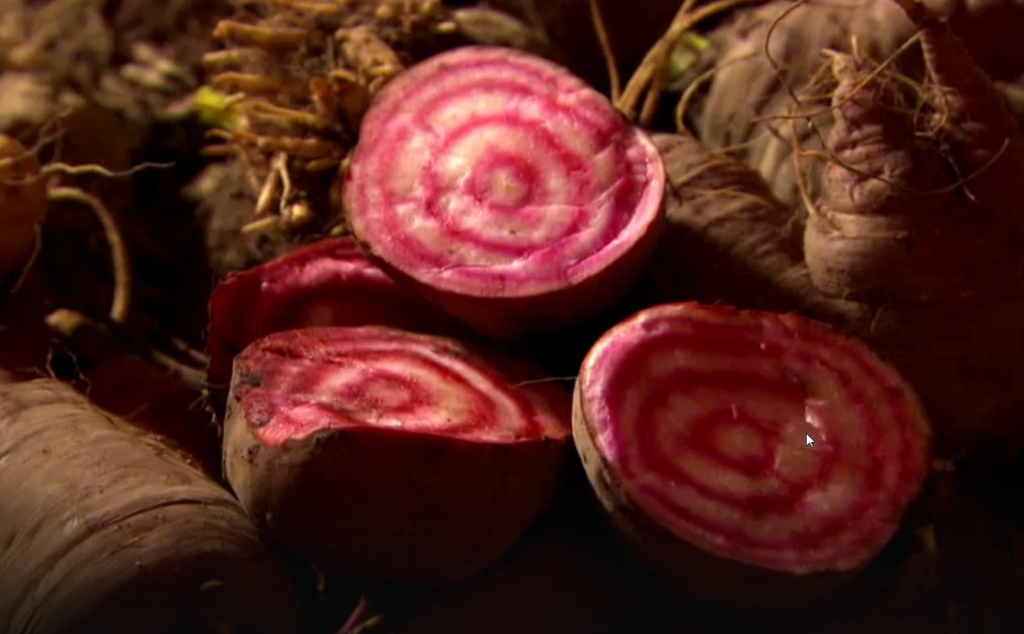Beetroot or red beet (Beta vulgaris L.) is a genuine winter vegetable. It’s in season from September through to now, the month of March. Nevertheless, we would like to take this opportunity to devote some attention to this incredibly valuable winter vegetable. This root vegetable is not only a real ‘artist’ with its impressive array of colours but also contains positive constituents. In Eastern Europe it is one of the fundamental ingredients on menus.
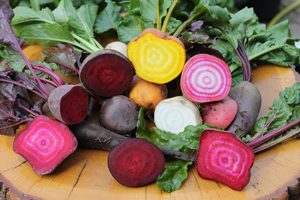 The magnificent composition of white and red in the main photo above is the work of the Italian “Tonda“ beet, which we know as “Chioggia” beet. “Boldor”, in contrast, is a bright yellow, round-shaped beet with an aromatic-sweet taste. The well-known, traditional variety of beetroot is an evenly coloured red bulb which is particularly good for pickling, juicing and boiling.
The magnificent composition of white and red in the main photo above is the work of the Italian “Tonda“ beet, which we know as “Chioggia” beet. “Boldor”, in contrast, is a bright yellow, round-shaped beet with an aromatic-sweet taste. The well-known, traditional variety of beetroot is an evenly coloured red bulb which is particularly good for pickling, juicing and boiling.
Health and nutrition
Beetroot is one of our home-grown superfoods here in Germany due to its high nutritional content. It contains especially high levels of potassium, iron and folic acid [1]. Iron and folic acid are important for formation of blood [2].
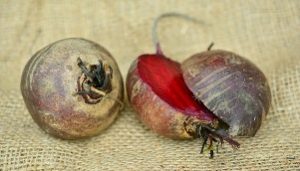 These bulbs also provide secondary plant substances such as betanin, which gives beetroot its colour and belongs to the betalains group [3]. Betanin is used as the additive E162 for natural colouring of foods such as yoghurt or ice-cream [4]. There is laboratory-based evidence that, due to these bioactive constituents in particular, extracts of beetroot have an antioxidant effect and inhibit inflammation [4] and cancer[5] [6]. Of all types of vegetables, beetroot actually has one of the highest antioxidant capacities [7].
These bulbs also provide secondary plant substances such as betanin, which gives beetroot its colour and belongs to the betalains group [3]. Betanin is used as the additive E162 for natural colouring of foods such as yoghurt or ice-cream [4]. There is laboratory-based evidence that, due to these bioactive constituents in particular, extracts of beetroot have an antioxidant effect and inhibit inflammation [4] and cancer[5] [6]. Of all types of vegetables, beetroot actually has one of the highest antioxidant capacities [7].
In a small-scale human-based study on patients with osteoarthritis, there was a reduction in pain in those that took a beetroot extract, and the values of the inflammation mediator TNF-alpha in the blood decreased [8]. In tests on mice, beetroot extract demonstrated a cancer-inhibiting effect in lung and skin cancer, even at low doses [9]. However, the anti-cancer activity has not yet been sufficiently researched. Further studies are essential before the exact mechanism of cancer inhibition is understood and findings from animal studies can be applied to humans.
It is important to note that beetroot also contains oxalic acid. People who are prone to the formation of calcium-oxalate stones in the kidneys should not eat too much of this root vegetable as the acid contained promotes the development of these kidney stones.
In the kitchen
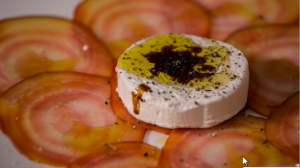 Beetroot can be enjoyed raw as well as cooked. Some varieties are better eaten raw, while others are better when cooked. The “Tonda” beet, for example, is especially suitable for eating raw as the impressive concentric rings of colour are lost when it is cooked without its skin. The slightly earthy after taste which is typical in uncooked root vegetables can be overcome by serving with fruit, seasonings or milk products. Beetroot is particularly nutritious when eaten raw. It can also be cooked – without the need for peeling – in the oven or in a steam cooker until tender (ideally al dente), and this is also the most gentle way to prepare this vegetable. The thin outer skin can then be easily peeled once it is cooked. We recommend wearing gloves when preparing cooked beetroot as it really stains. If, despite this, you get a splash on your clothing or elsewhere, lemon juice helps.
Beetroot can be enjoyed raw as well as cooked. Some varieties are better eaten raw, while others are better when cooked. The “Tonda” beet, for example, is especially suitable for eating raw as the impressive concentric rings of colour are lost when it is cooked without its skin. The slightly earthy after taste which is typical in uncooked root vegetables can be overcome by serving with fruit, seasonings or milk products. Beetroot is particularly nutritious when eaten raw. It can also be cooked – without the need for peeling – in the oven or in a steam cooker until tender (ideally al dente), and this is also the most gentle way to prepare this vegetable. The thin outer skin can then be easily peeled once it is cooked. We recommend wearing gloves when preparing cooked beetroot as it really stains. If, despite this, you get a splash on your clothing or elsewhere, lemon juice helps.
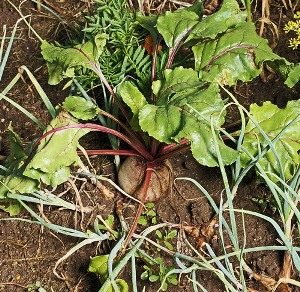 As for all food products, it is also especially the case for beetroot that the origin of the vegetable plays a crucial role in determining its nutritional value. If you are not eating home-grown vegetables, then try to buy them from an organic source. Organic farming methods do not use nitrate-based fertilisers, which means that the bulbs have a lower nitrate content. The ensuing nitrite is involved in the formation of nitrosamines, which are carcinogenic [2]. This means that the less nitrate the vegetable provides as a substrate, the better it is for our health.
As for all food products, it is also especially the case for beetroot that the origin of the vegetable plays a crucial role in determining its nutritional value. If you are not eating home-grown vegetables, then try to buy them from an organic source. Organic farming methods do not use nitrate-based fertilisers, which means that the bulbs have a lower nitrate content. The ensuing nitrite is involved in the formation of nitrosamines, which are carcinogenic [2]. This means that the less nitrate the vegetable provides as a substrate, the better it is for our health.
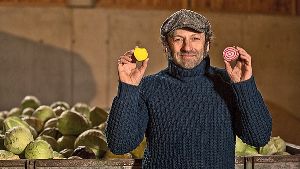 If you are keen to try this colourful winter vegetable, you will enjoy our blog next Monday as we will be posting a delicious recipe here for you. And why not take a look at the programme “Max Schmidt and winter vegetables” in the BR-Mediathek, in which sensational dishes are created using winter vegetables and their positive effect on health is explained. You can also find the recipes connected to this programme here.
If you are keen to try this colourful winter vegetable, you will enjoy our blog next Monday as we will be posting a delicious recipe here for you. And why not take a look at the programme “Max Schmidt and winter vegetables” in the BR-Mediathek, in which sensational dishes are created using winter vegetables and their positive effect on health is explained. You can also find the recipes connected to this programme here.
Sources:
[1] B Heseker & H Heseker, Nährstoffe in Lebensmitteln – Die große Energie- und Nährstofftabelle, Sulzbach im Taunus: Umschau Zeitschriftenverlag, 2013.
[2] HK Biesalski, P Grimm, S Nowitzki-Grimm, Taschenatlas der Ernährung, Stuttgart: Thieme Verlag, 2015.
[3] EJ Lee et al., „Betalain and betaine composition of greenhouse- or field-produced beetroot Beta vulgaris L.) and inhibition of HepG2 cell proliferation,“ J Agric Food Chem., Feb 2014, 62(6) pp. 1324-31.
[4] VG Georgiev et al., „Antioxidant activity and phenolic content of betalain extracts from intact plants and hairy root cultures of the red beetroot Beta vulgaris cv. Detroit dark red.,“ Plant Foods Hum Nutr, Jun 2010, 65(2) pp. 105-11.
[5] GJ Kapadia et al., „Cytotoxic effect of the red beetroot (Beta vulgaris L.) extract compared to doxorubicin (Adriamycin) in the human prostate (PC-3) and breast (MCF-7) cancer cell lines,“ Anticancer Agents Med Chem. , Mar 2011; pp. 280-4.
[6] GJ Kapadia et al., „Synergistic cytotoxicity of red beetroot (Beta vulgaris L.) extract with doxorubicin in human pancreatic, breast and prostate cancer cell lines,“ J Complement Integr Med, Jun 2013; pp. 113-122.
[7] JA Vinson et al., „Phenol Antioxidant Quantity and Quality in Foods: Vegetables,“ Journal of Agricultural and Food Chemistry , 1998, 46(9) pp. 3630-3634.
[8] Z Pietrzkowski et al., „Influence of betalin-rich extracts on reduction of discomfort associated with osteoarthritis,“ New. Med., 2010(1) pp. 12-17.
[9] GJ Kapadia et al., „Chemoprevention of DMBA-induced UV-B promoted, NOR-1-induced TPA promoted skin carcinogenesis, and DEN-induced phenobarbital promoted liver tumors in mice by extract of beetroot.,“ Pharmacol Res., Feb 2003, 47(2) pp. 141-8.
